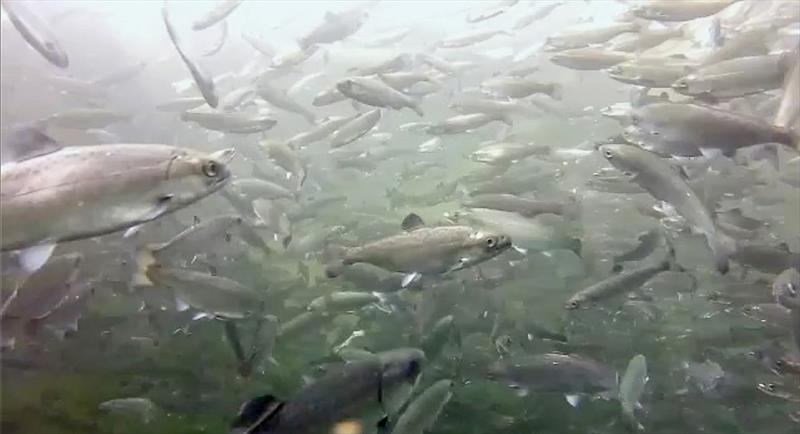
Unsettled Pacific Ocean offers few clear indicators for salmon success in 2024
by NOAA Fisheries 20 Jan 2024 20:19 UTC

Acoustically tagged and untagged juvenile Chinook salmon ready to be released from a net pen to begin their ocean migration © NOAA Fisheries
Want to learn how the Pacific Ocean is likely to change and affect salmon survival in the coming year? Stay tuned, scientists say.
The ocean indicators that NOAA's Northwest Fisheries Science Center researchers track off Newport, on the Central Oregon Coast, are decidedly mixed for the coming year. El Niño is still developing at the equator and there are both positive and negative indicators in local waters for emerging salmon. The ocean indicators of juvenile salmon survival—now online—reflect a rapidly changing ocean that is tough to predict.
"We're not seeing any clear direction as we sometimes have before," said Jennifer Fisher, a research fisheries biologist at the Science Center's Newport Research Station. "The overall message is that the system is unsettled. We'd like to be able to tease something out of that, but right now, we have to watch and wait."
The Research Station's team regularly monitors ocean conditions along the Newport Hydrographic Line, one of the best records of ocean change on the West Coast. Scientists have surveyed the line twice monthly (weather permitting) for 26 years. The information collected reveals patterns and insights into how the ocean changes, particularly how the changes are likely to affect the salmon experiencing those conditions.
Key indicators send conflicting messages
The team tracks 16 key ocean indicators including seawater temperature and salinity and the number and types of copepods, tiny crustaceans that reflect the food quality for juvenile salmon when they first enter the ocean. Decades of monitoring have demonstrated that these ocean indicators correlate with juvenile salmon growth and survival—and how many adults will return to rivers to spawn.
"These are factors that influence the health and survival of salmon, so we can often connect that with how salmon will fare," Fisher said. "Right now, though, the picture is not so clear."
This year ranked 11 out of the 26 years on record for conditions benefiting salmon, leaving the picture murky. The Pacific Decadal Oscillation, a climate pattern affecting the Pacific, indicated conditions that often benefit salmon. However, the local and regional temperatures affecting salmon varied over the summer, indicating more contradictory conditions.
The copepods were cooler water species that are rich in fats and help fuel the growth of young salmon. But the abundance of these high-fat crustaceans was lower than in some years. Survey catches of juvenile salmon showed slightly fewer yearling Chinook salmon than usual, but more coho salmon than usual.
Warm sea surface temperatures along the equator reflected the emergence of an El Niño climate pattern earlier this year. However, the effects that often include increased storms and precipitation in California and warmer temperatures in the Pacific Northwest have yet to appear along the West Coast. That is not unusual, as El Niño effects often arrive on the West Coast in the winter and spring of the following year—in this case, 2024.
Waiting and watching
So scientists are watching carefully. The contrast between warm equatorial El Niño conditions and the negative Pacific Decadal Oscillation pattern in the north Pacific has occurred in the past. But this is the first time in 26 years these two indices have contrasted so greatly. That further suggests mixed conditions that will take some months—and perhaps longer—to play out, scientists concluded.